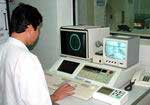On April 27, in Hanoi, the Ministry of Health organized a conference on the application of information technology in hospital management for 2006, along with development orientations for the 2006-2010 period. The event saw the attendance of leaders from health departments of provinces and cities, as well as major hospitals nationwide.
 |
Reading diagnostics on a CT scan at the Provincial General Hospital |
Currently, the application of information technology in hospital management has become an urgent requirement to enhance the quality of hospital management, contributing to the comprehensive development of hospitals and gradually meeting the demands for diagnosis and healthcare services for the public. Reality shows that many financially capable hospitals have independently developed synchronized hospital management software systems and successfully applied IT in hospital management, such as Hanoi Obstetrics and Gynecology Hospital and Central Pediatric Hospital.
The application of information technology has helped hospitals manage and utilize resources effectively, standardize fee collection, ensure financial transparency for patients, and facilitate safe and rational medication use.
In addition to successfully applying IT in management, many hospitals have established their own electronic information pages with diverse and attractive professional content, such as Viet Duc Hospital, Central Pediatric Hospital, and Cho Ray Hospital, contributing to bringing medical services closer to the public.
However, during this conference, many delegates frankly pointed out that the application of information technology in hospital management in Vietnam still has many limitations and lags far behind many countries worldwide.
According to reports from hospitals across the country, the application of information technology in most Vietnamese hospitals currently remains limited to office work, statistics, and reporting. Some hospitals have only implemented individual components, such as personnel management, fee management, drug inventory management, and patient admission and discharge processes, with only a few hospitals deploying integrated management for patients throughout the treatment process.
According to data from the Treatment Department (Ministry of Health), in 2005, there were nearly 1,000 public hospitals nationwide, but only about 5% had relatively comprehensive hospital management software, developed by dozens of different software providers. In some hospitals, issues arose, such as a patient’s health insurance information needing to be entered three times across three different software systems (hospital management software; health insurance payment software; statistical reporting management software), causing inconvenience for patients and wasting hospital staff resources on data entry.
Many delegates also raised other issues, such as the computers used in hospitals being outdated, the network systems being too old, poor design consulting, and the limited expertise of staff in many hospitals, leading to difficulties in implementing hospital management software.
The conference reached a consensus to strengthen the application of information technology in hospital management, focusing on enhancing hospital activity management based on IT systems, increasing the operational capacity of staff, helping managers quickly and accurately grasp information; simplifying administrative procedures, reducing intermediary activities, and facilitating prompt, convenient, and timely healthcare services; and standardizing data for sector management activities.




















































